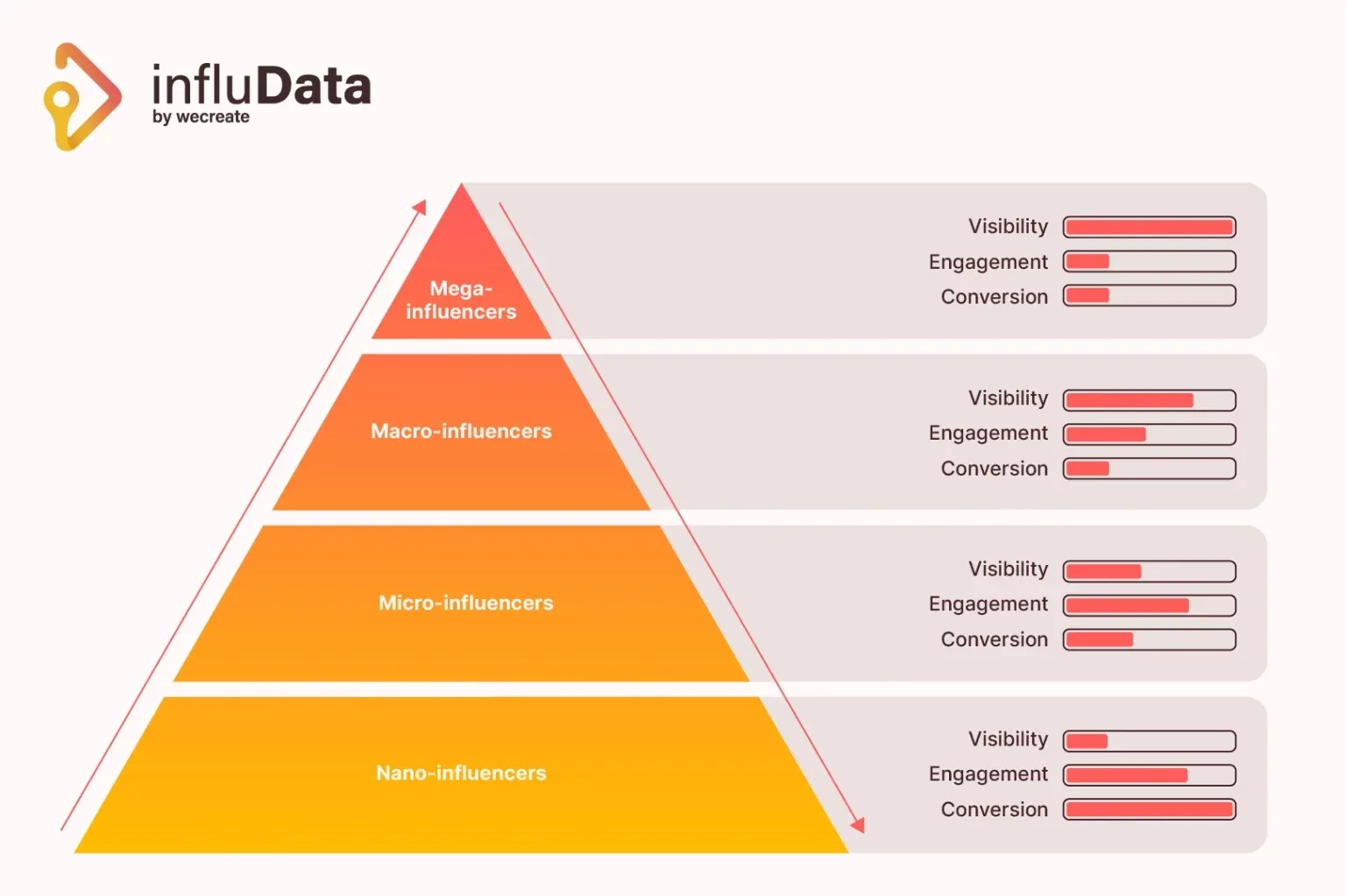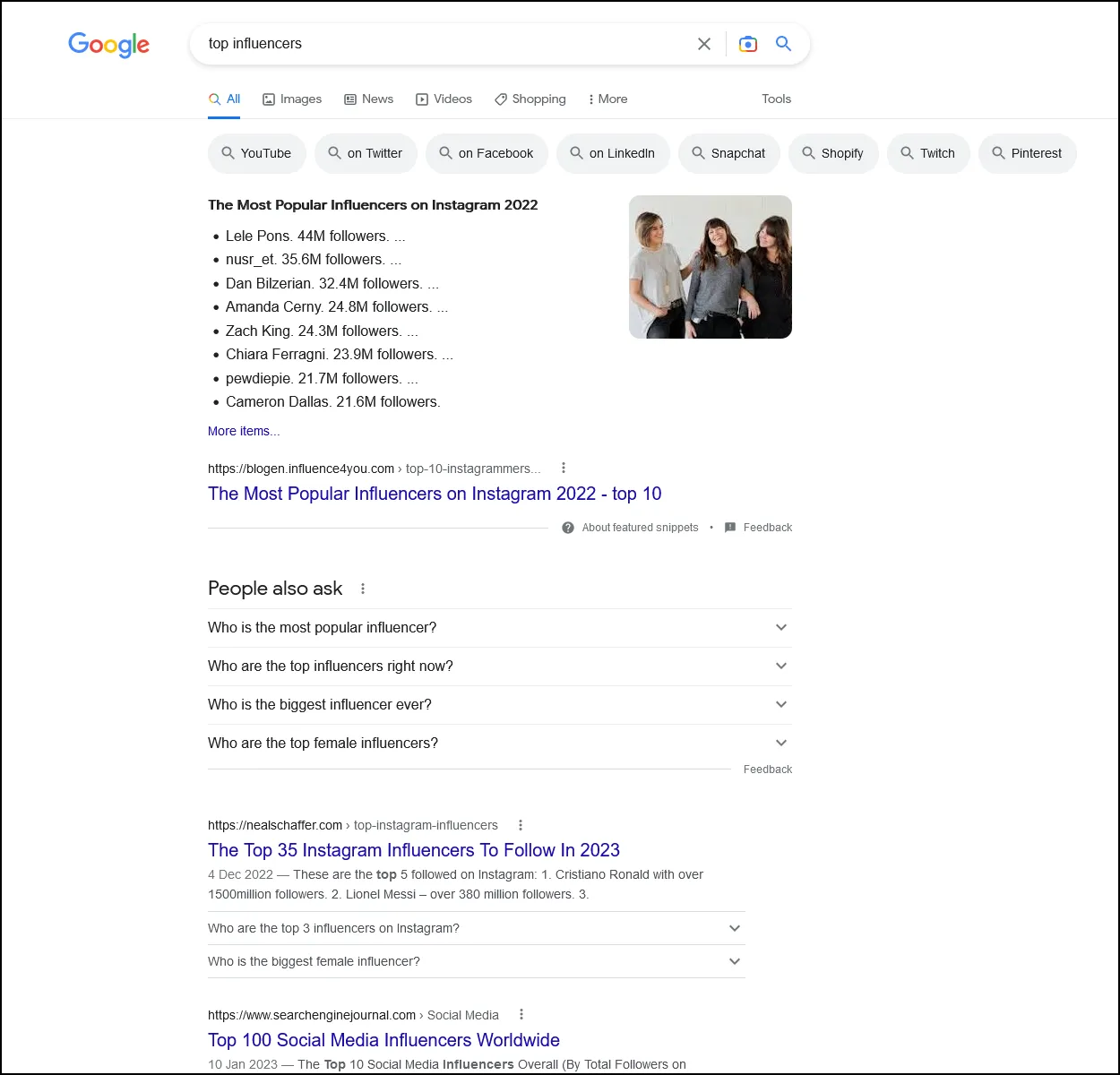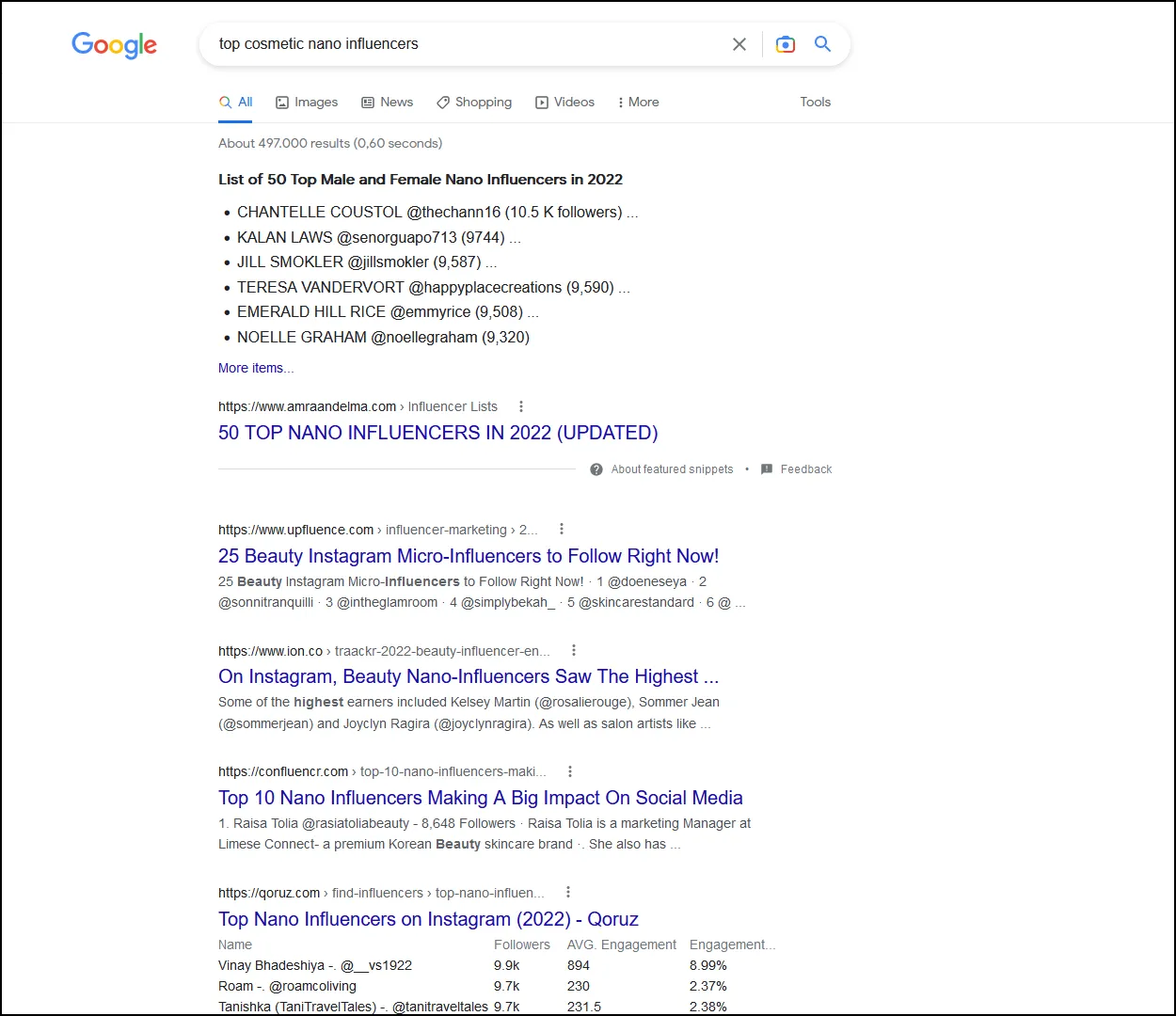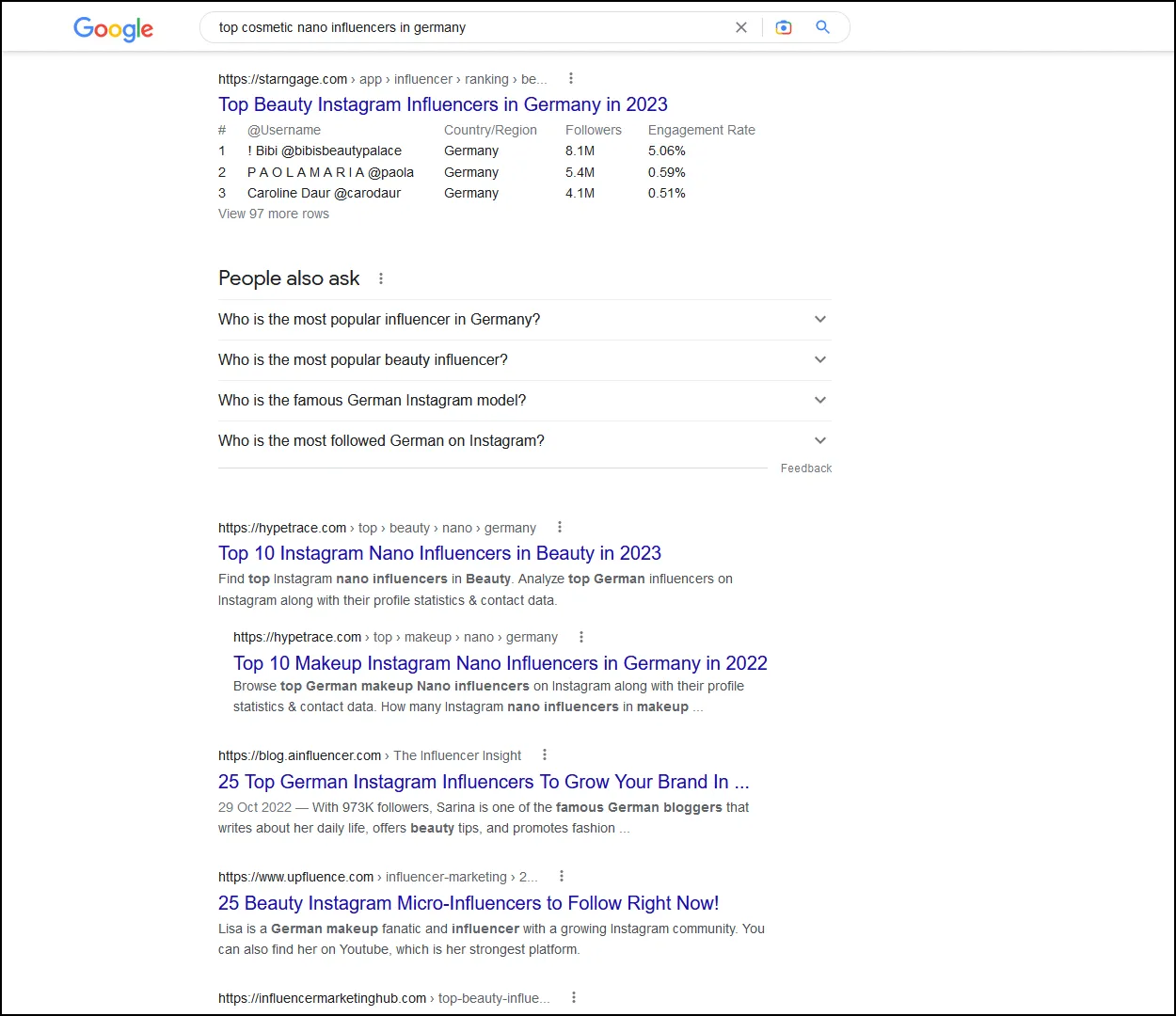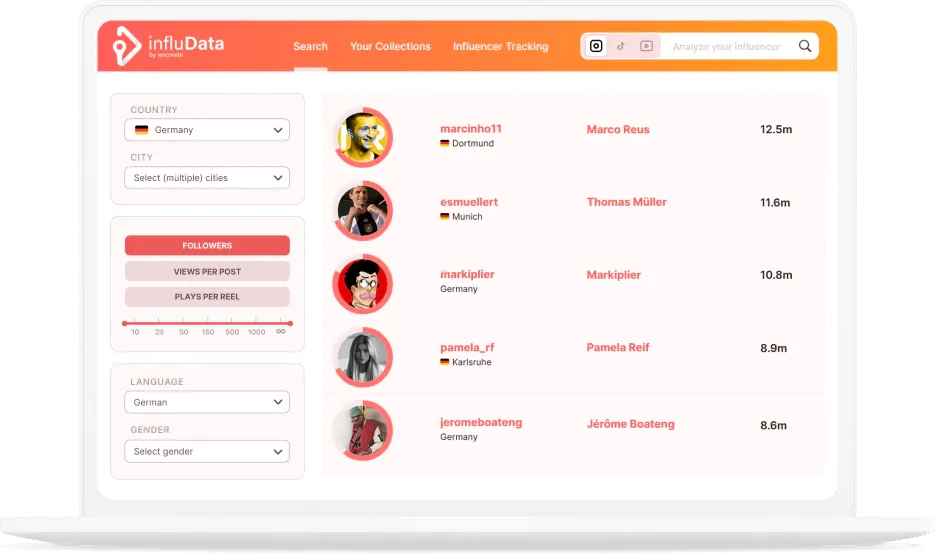
Reading time: 19 minutes
Despite influencer marketing’s ever-growing popularity, several misconceptions have persisted over time. It’s time to clear them up.
False assumptions exist in every area of life, just as a lot of myths in influencer marketing have persisted to this day. We take a closer look at them and clarify what is true and what is false.
But first, a few examples of what influencer marketing can achieve (guaranteed myth-free):
H&M collaborated with four celebrity influencers to build brand awareness and drive sales during the holiday season. Throughout this campaign, they managed to reach more than 12 million consumers and achieved an impressive 10% engagement rate.
Olay partnered with nine diverse women influencers (also called “Fearless 9”) to establish brand affinity and increase awareness. With their charm and massive following, the Fearless 9 helped the brand garner 298K video views and an engagement rate of 8.33% – which is truly impressive.
Similarly, several other large consumer brands like Nike, Dunkin’ Donuts, and many more have leveraged influencer marketing as a means to increase brand awareness, drive sales, and build trust. And while large companies have been pouring millions of dollars into influencer marketing, SMBs are not missing out on the action.
For example, Lumene, a Finnish skincare brand, partnered with over 88 local micro-influencers to promote the launch of their new product line in Finland. Through this campaign, the skincare brand managed to reach more than 150,000 people and received 21,000+ likes. Alongside this, the posts published as part of this campaign were saved more than 3,000 times – meaning more than 3,000 people planned to return to these posts.
Brands are Leveraging Influencer Marketing to Drive Insane Results
The influencer marketing market, in total, was valued at around $16.4 billion in 2022. Brands of all sizes, from SMBs to enterprises, are turning to influencer marketing to reach their target audiences and increase sales.
However, despite its tremendous growth, there are a couple of myths holding the global influencer marketing market back.
Some brands are under the assumption that influencer marketing is extremely expensive and suited for enterprises with gigantic-sized budgets only. On the other hand, some think it’s literally impossible to track the performance of influencer marketing campaigns.
These misconceptions are factors stopping millions of brands from leveraging influencer marketing.
To debunk these myths, we’ve put together this blog post. Throughout this piece, we’ll shed light on seven long-lived influencer marketing myths that need some serious busting. Excited to dive in with us? Let’s start.
Debunking the Top 7 Influencer Marketing Myths
To help you understand the true power and potential of influencer marketing and clear up any confusion, we’ve put together seven long-lived influencer marketing myths. These include:
Table of Contents:
- The More Popular And The More Followers An Influencer Has, The Better-Suited He/She Is To Promote A Product
- Influencer Marketing Is Extremely Expensive And Only Suited For Large Companies With Gigantic-Sized Budgets
- Finding The Right Influencers To Collaborate With Can Easily Be Done Via A Quick Google Search
- Companies Should Not Take Instagram & Tiktok Seriously At All
- All Influencers Buy Followers To Attract Marketing And Advertising Partners
- Influencer Marketing Is Not Suitable For B2B Brands
- It’s Literally Impossible To Track The Performance Of An Influencer Marketing Campaign
Let’s put an end to these myths one by one.
Myth 1: The More Popular And The More Followers An Influencer Has, The Better-Suited He/She Is To Promote A Product
A common misbelief among many businesses and marketers is that they must partner with well-known macro or mega influencers (influencers with large followings of at least half a million people) for their campaigns to be successful. It’s understandable that they think this way. After all, famous influencers with large followings can help them reach out to a wider audience, right?
If your aim is to get as much reach as possible, it makes sense to work with macro or mega influencers. But what if we tell you that these influencers normally have a poor engagement rate? Working with influencers with large followings doesn’t guarantee the high engagement you are looking for.
Allow us to share an example:
Suppose you run a cosmetic brand in the US and plan to collaborate with a US-based influencer, named John, with 500,000 followers to promote one of your products worth $30. In this case, let’s assume his engagement rate is at normal heights i.e., 3%.
Based on this, let’s calculate how many followers are likely to engage with his posts. We’ll do this by multiplying the engagement rate (3%) by the total number of his followers (500,000).
It equals – 3% x 500,000 = 15,000 followers.
NOTE: These are people who just engage with the posts. Not all of these 15,000 followers will purchase from you after your collaboration with the influencer.
Now, if John charges $5,000 per Instagram post, and you request John’s package of five posts, the total campaign cost would be $25,000. Let’s say after your collaboration with him, 700 people purchased your latest product, resulting in $30 x 700 = $21,000 in added revenue.
You drove $21,000 in added revenue. However, the influencer marketing campaign itself cost you $25,000. And note: $21,000 isn’t even the gross profit. That’s your revenue!
This means – collaborating with John didn’t help you generate a positive ROI.
Honestly, we believe that a large following doesn’t matter – especially if you are expecting Conversions as the outcome of your campaign.
It’s no secret that many macro and mega influencers don’t have a well-engaged audience. On the other hand, nano or micro-influencers (influencers with a low follower count of max. 100K) have a much better engagement rate. Why? That’s because they know their audience better than macro or mega influencers do.
And they have the time and make extra efforts to interact with their followers. Also, we’d like to highlight that a majority of nano and micro-influencers have a niche they stick to and in which they are absolute experts, like fitness, beauty, etc. As a result, their followers are extremely interested in what they post.
As the infographic suggests, while nano and micro-influencers have comparatively lesser visibility than macro or mega-influencers, their content is subject to higher engagement and conversion.
Why? Allow us to share the reasons:
- They actively interact with their followers and have built healthy relationships with them.
- Their followers are highly engaged and loyal.
- They have a niche audience they stick to.
- They have a better ability to generate trust among their followers.
- They have high growth potential, which means partnering with the right nano and micro-influencers now will likely help a brand get better deals in the future.
And you know what’s so fascinating about working with these influencers? They don’t charge as much as macro or mega influencers do. This brings us to our second myth.
Myth 2: Influencer Marketing Is Extremely Expensive And Only Suited For Large Companies With Gigantic-Sized Budgets
If you’ve reached out to a macro or mega influencer, you may have probably received similar pricing.
| 1 TikTok Video | $8,000 |
|---|---|
| 1 IG In-Feed | $7,000 |
| 1 Instagram Reel | $8,000 |
| 1 Instagram Story Set | $6,000 |
Brands with a monthly influencer marketing budget of $3,000 per month can’t afford to pay these rates. This brings us to the question: “Do influencers charge this much?”
Mega and macro influencers do. Celebrity influencers charge higher. However, nano and micro-influencers don’t charge as much. To help you better understand the charging practices of influencers, we put together this little table comprising information about what different types of influencers charge for different content formats.
| Type of Influencer | Instagram Post | YouTube Video | TikTok Video |
|---|---|---|---|
| Nano-Influencers | $10 – $100 per post | $20 – $200 per video | $5 – $25 per post |
| Micro-Influencers | $100 – $500 per post | $200 – $1,000 per video | $25 – $125 per post |
| Macro-Influencers | $5,000 – $10,000 per post | $10,000 – $20,000 per video | $1,250 – $2,500 per post |
| Mega-Influencers | $10,000 per post | $20,000 per video | $2,500 per post |
Source: https://influencermarketinghub.com/influencer-rates/
You see – the difference between what nano and micro-influencers charge vs. what macro and mega influencers do is huge. And as we mentioned earlier, collaborating with nano and micro-influencers is more beneficial than hiring macro or mega influencers.
Alongside this, there are several factors that impact the pricing like the aim of the campaign and runtime. If the campaign is supposed to run for several months, you can negotiate a deal with the influencer you want to hire, etc..
Apart from paying influencers their fixed rates, there are several other ways to get influencers to promote your brand for little money, like providing a fixed commission to influencers for every product they help sell, or sending them your product as a gift and crossing your fingers that they will post about it on their social media platforms (a so-called barter deal).
As you can see, influencers can be expensive. But they do not have to be if you negotiate well and find the fitting influencers for your budget and purpose! That being said, we have the perfect transition to our next myth.
Myth 3: Finding The Right Influencers To Collaborate With Can Easily Be Done Via A Quick Google Search
Forget about finding the right influencers via a quick Google search! Only a small part of influencers can be found via a quick Google search. And the ones you will find, are either not suited for you or will be influencers with large followings – which may not be suited for your company’s budget. To prove our point, we looked up the keyword “top influencers” on Google, and here’s the top result with the featured snippet.
Every influencer you see up there has millions of followers. So, they’re probably going to charge thousands of dollars per post. Let’s try to find nano influencers – which might be better suited for your niche and wallet. To do this, we looked up the keyword “top nano influencers” and here’s the featured snippet.
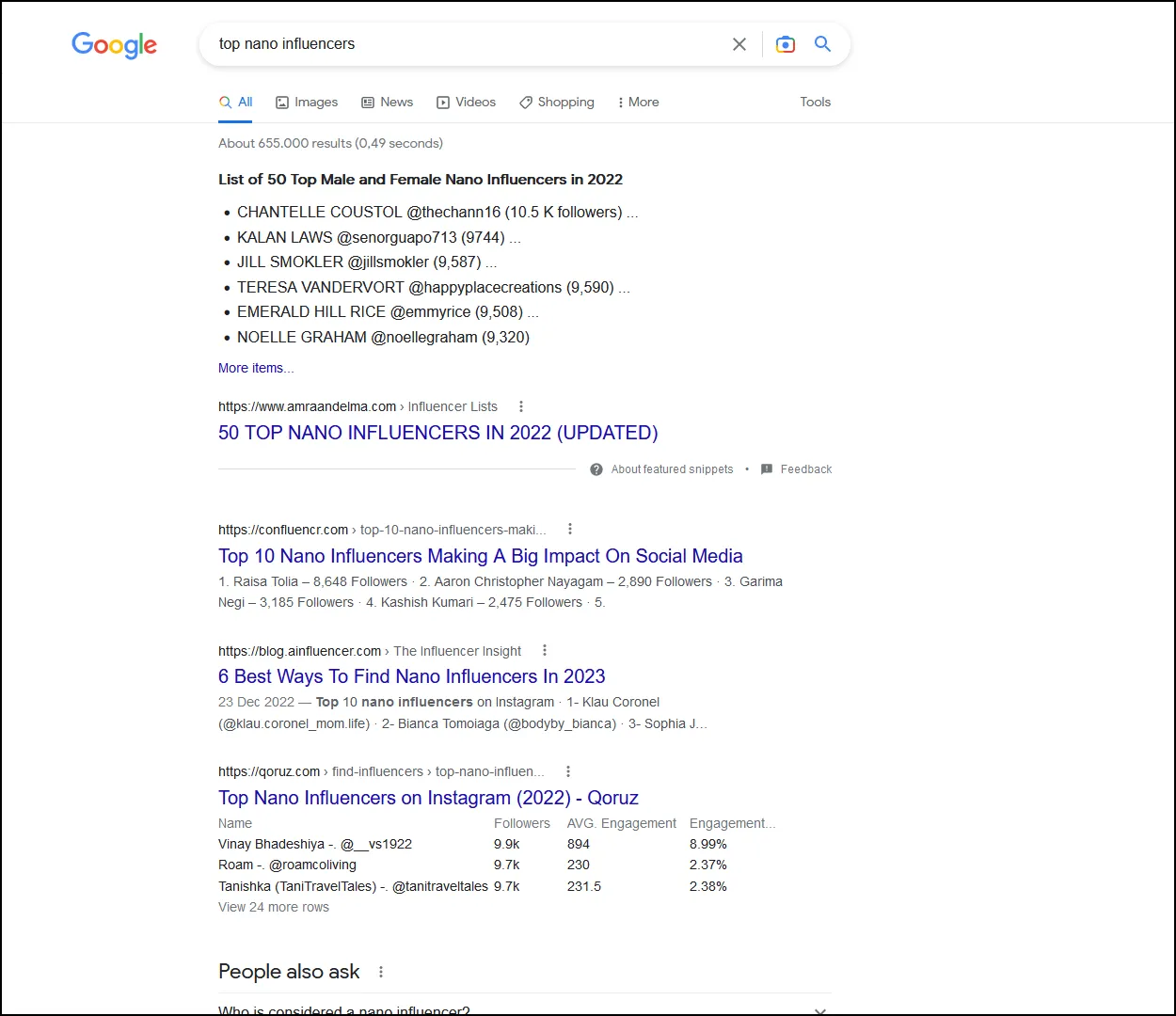
This list is good, but it does not offer you any more insights into the niche these influencers are in, their audience, or their engagement rate. But what if you’re looking for cosmetic nano-influencers? Well, you can always look up a keyword like “top cosmetic nano influencers.” We did exactly that, but didn’t come across an article that focused solely on cosmetic nano influencers. The results were generic and absolutely not fitting. The influencers found via Google search are not perfectly suited to set up a results-driven campaign.
Let’s narrow it down further. What if you’re looking for cosmetic nano-influencers based in Germany?
Look at the top result – it comprises a list of influencers with millions of followers. So even though our query was focused on nano-influencers, Google fetched us an article with a list of influencers that have millions of followers each (and additionally poor engagement rate).
This proves that a quick Google search won’t help you find the right influencers. You can obviously look up influencers on social media one by one; but that’s just too much manual work. And you’ll have no direction if you choose to go down that path. Also, you will never find out data concerning their audience, engagement details or fake activities. Comparing these influencers with similar ones is also a challenge. This kind of information can hardly ever be found via Google search.
So, what’s the best way to look for the right influencers that fit your needs?
With an influencer discovery tool like influData, you can search and analyze creators worldwide. The platform offers intuitive discovery options and helps brands narrow down their influencer search by applying filters like location, social media platform, views per post, plays per reel, followers, language, gender, and more. These results can further be analyzed to assess their suitability for brand partnerships by examining the follower history, posting frequency, engagement levels, brand and media value, as well as audience insights. Additionally, you can find out if this account was engaged in any kind of fake activities as well as compare the influencers’ performance to similar creators. It’s literally impossible to achieve this level of granularity and depth via manual searching. Lastly, you’ll also be able to compare the performance of different influencers side-by-side.
Myth 4: Companies Should Not Take Instagram & Tiktok Seriously At All
There are some marketers and brands out there who believe that Instagram or TikTok shouldn’t be taken seriously. They’re under the assumption that these platforms are solely for fun and only for kids; nothing else. They recommend other people in their network to shift their focus to serious platforms like Twitter or LinkedIn, since everyone knows that Instagram and TikTok are not important for companies to be represented on. Should you avoid running influencer marketing campaigns on TikTok and Instagram? The answer is no!
According to Data Reportal’s October 2022 report, Instagram is the world’s fourth-most used social media platform with 1.3 billion active users (also counting WhatsApp as a social media platform).
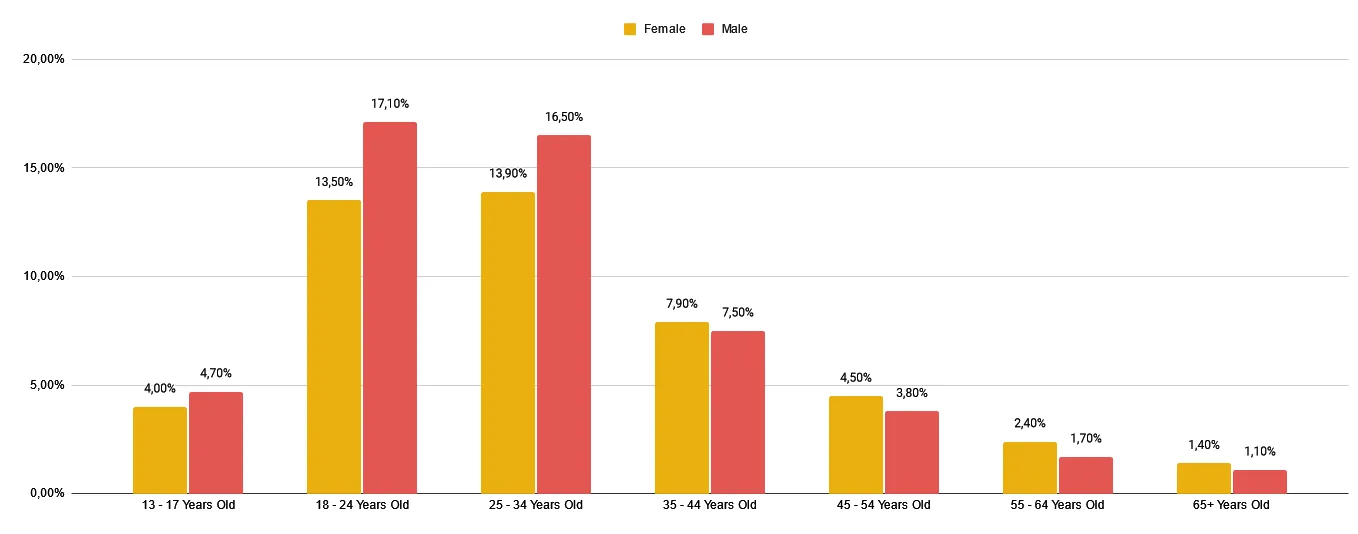
At the same time, it’s important to note that a majority of Instagram users belong to the age group 18-34 years old.
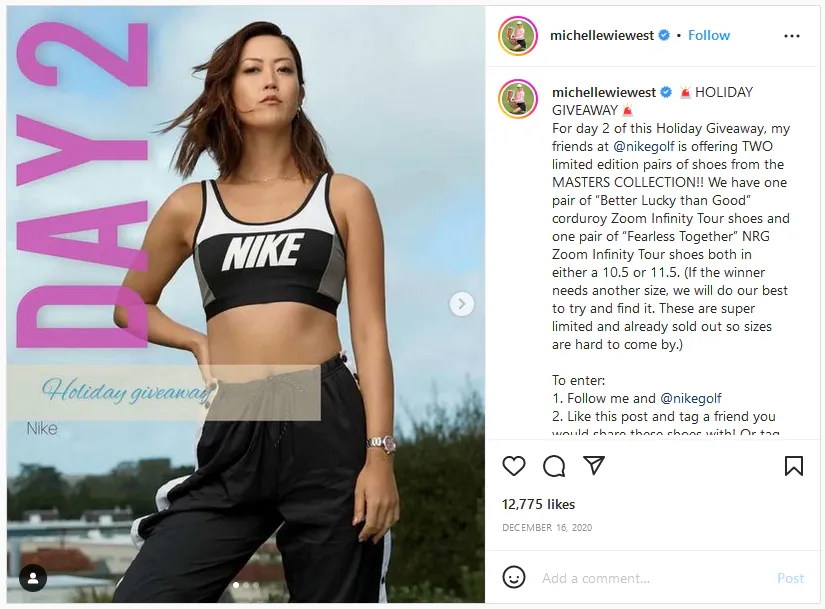
Nike partners with Instagram influencers all the time. And it’s no secret that the sports brand has seen outstanding results with its Instagram influencer marketing campaigns.
On the other hand, TikTok is one of the fastest-growing social media platforms with nearly one billion active users.
TikTok may have a reputation for being a platform for young folks only, but that’s not entirely true.
According to influData, a good chunk of TikToks’ users are in the 18-22 age range (around 38%), but there’s also a significant number of older people on there.
Around 21-22% are between 23 and 30, 8-9% are between 31 and 40, and even 2.5-3.5% of the users are over 40.
Plus, in recent months, more and more older users have joined TikTok. Just like how Facebook and Instagram started off as platforms for the young, but now attract older users too, TikTok is also growing to be more inclusive in terms of age demographics. Brands like Red Bull, Kroger, and Calvin Klein have achieved incredible results by running influencer marketing campaigns on TikTok.
We’re not saying that you should ignore Twitter. Or you should not start your own blog. But alongside this, you should be visible to your audience across multiple channels. The more your audience sees you, the more likely they’re to trust you. If one of your potential customers sees an influencer promoting your product on TikTok and later sees another influencer promoting your product on Instagram, he/she is highly likely to make a purchase.
Having multiple touchpoints in today’s world is incredibly important – from having a physical presence in the form of shops to an online shop to newsletters, company social media pages, and more. Different people shop across different channels, and by missing out on a channel, you are missing out on your potential customers. That’s why running influencer marketing campaigns across different channels is super-important.
Think of it as a game of tag. You want to tag them as many times as possible with your message. That’s why missing out on Insta and TikTok might mean that you are missing out on your target group and potential buyers!
Myth 5: All Influencers Buy Followers To Attract Marketing And Advertising Partners
Do influencers buy followers? Yes!
Do all influencers buy followers? No!
There are many influencers out there with millions of followers yet extremely low engagement. Some macro influencers might have 100 likes on their posts or 10-12 comments. You can see it at a glance that these are influencers who have likely purchased fake followers. And that’s not all. Some influencers also purchase likes and comments on their posts. It’s easy and cheap to purchase fake followers and engagement. On the other hand, some nano or micro-influencers have incredibly high engagement rates as a result of their high-quality, engaging content. These influencers are genuine.
Do not get us wrong: Not all big influencers are fraudulent and not all nano or micro-influencers are perfect.
If you work with influencers that have purchased fake followers, your campaigns will deliver poor results. That’s the reason it’s critical to thoroughly vet the influencers before you start working with them – no matter what category they are in.
There are a few ways to identify fake followers as well as fake engagement. To detect fake followers, just look at the number of followers the respective influencers have and compare that with the engagement they get on their posts. If an influencer has 100,000 followers yet their posts get only 10-12 likes and 3-4 comments, then that’s fishy! But don’t just end your quest there. Look for signs of fake engagement. To detect fake engagement, review the influencer’s engagement on multiple posts; do it for 7-10 posts. If you see generic comments like “Epic,” “Beautiful,” and “Cute,” then chances are that the influencer has purchased fake engagement. Yes – some real followers are likely to drop lazy comments. But if you see that a majority of comments are generic, then that’s a red alert!
With tools like influData, brands can easily identify if the followership is authentic or fake at a single glance. influData looks for mass followers, and inactive followers, and identifies influencers using the like-for-like method. At the same time, this tool provides information on whether an influencer’s followership is constantly growing or fluctuating and if there’s any suspicious activity. We highly recommend conducting thorough research before engaging with an influencer. Do it manually and with a tool!
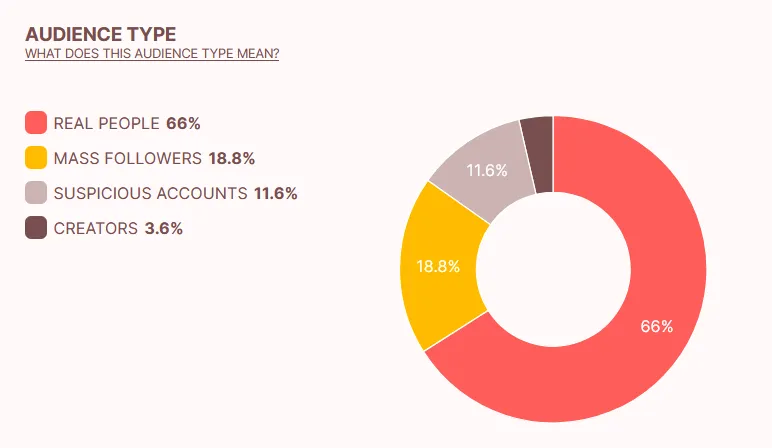
Myth 6: Influencer Marketing Is Not Suitable For B2B Brands
B2B purchases usually have no single decision-maker involved. The sales cycles are longer. So, how can influencer marketing help B2B companies drive sales?
According to a Search Engine Journal article, 86% of B2B companies find success with influencer marketing. The point of B2B influencer marketing isn’t to drive instant purchases; instead, it’s to increase awareness and boost brand reputation.
But it’s important to note that you need to be really picky about who you work with. You need to make sure that the influencers you work with are subject matter experts and that your audience finds them trustworthy. You can’t hire just about anyone to promote your B2B products or services. Here are the top qualities marketers should look for in a B2B influencer, according to the same Search Engine Journal article:
- Relevance of audience (98%)
- Audience sees them as trustworthy (87%)
- Subject matter expertise (78%)
- Values align with the brand (69%)
- Influencer publishes on at least one platform (65%)
- Ability to create content (54%)
- Size of audience (49%)
- Professional credentials (42%)
- Advocate for our brand (33%)
There are several success stories of B2B companies achieving excellent results with influencer marketing.
SAP works with B2B influencers like academics, authors, and business consultants to create relevant content around their different offerings, work with them at suitable events, and increase brand awareness. They invited five influencers to one of their events to discuss topics like data analytics, machine learning, and IoT. These influencers drove more than half of the overall social media mentions about this event.
American Express collaborated with bloggers like Emily Henderson and Grace Bonney to promote their campaign called “Love My Store.” The whole point of the campaign was to let people know that it’s not just large enterprises that accept credit cards, but small businesses do as well. The campaign helped American Express earn over five million impressions and led to the distribution of 400,000 Amex decals.
Myth 7: It’s Literally Impossible To Track The Performance Of An Influencer Marketing Campaign
Marketers face many challenges while trying to track the performance of their influencer marketing campaigns.
Many brands find it incredibly difficult to link their influencer marketing activities to specific revenue or sales. You’d want to know if the influencers drove purchases, right? It’s literally impossible to find out unless you use affiliate links or personalized discount codes.
Tracking the success of your influencer marketing campaigns is hard. There’s no doubt about it. However, with the above-mentioned affiliate links, personalized discounts, and especially the right tools like influData, brands can smartly track the performance of their campaigns. With influData, you can add creators to one or more of your campaigns and get a complete overview of their stories and posts from the moment you start tracking them. You can do this for every single influencer you work with, allowing you to dive deeper into individual creators’ campaign results.
You’ll also have access to the post’s date, and engagement such as likes and comments along with hashtags and mentions used. Lastly, you can apply filters to find your own mentions, hashtags, and links featured in posts and stories. Goodbye manual monitoring and Excel sheets!
In June 2023, influData will also launch its Campaign Reporting feature, providing even more in-depth insights, key performance indicators, and details pertaining to influencer marketing campaigns. This will include reports, content analysis, cost-per-thousand analysis, “Shit-storm alerts“ and more.
Conclusion
Companies are often skeptical about investing in influencer marketing as a result of the prevalent myths we’ve mentioned in this post. Hope we were able to clear them up for you.
You don’t necessarily need to hire influencers with millions of followers for your campaigns to be successful. Not all influencers buy followers. And it’s 100% possible to track the performance of your influencer marketing campaigns.
influData makes it easier for companies to discover and analyse influencers, detect influencers with fake followers, track their influencer marketing campaigns, and more.
